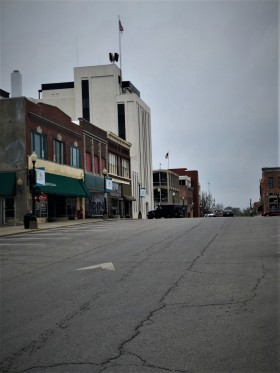My downtown is closed. Yours is likely closed also. The sound of the courthouse clock spreads across the perfect grids of empty streets and darkened stores as a reminder that this place has been a gathering point for our community for two hundred years….TWO HUNDRED years.

It has seen times of prosperity and times of hardship. It bustled during the days of western expansion with thousands of Santa Fe traders, Gold Rushers and Pioneers. It busted as the Civil War took its final tolls. It rallied in unity during the World Wars and flourished with shoppers afterwards. It lost some brick and mortar residents to fires and mid-century urban renewal. It nearly perished in the age of big box monopolies that turned the farms along the highways and interstate into concrete mega centers. And then, once again, it was filled with life and vibrancy. Our historic downtowns are more than a place to grab lunch or a unique birthday gift. They are an entity in themselves, a social and economic ecosystem filled with symbiotic benefits in every detail.
When our historic buildings are occupied by thriving businesses they are loved and maintained. For every $100 spent at a locally owned business, $68 is retained in the community compared to $43 by a non-locally owned business.[1] That money ends up in the bank accounts of employees, local service providers, local accountants, attorneys and insurance providers. Often the bank accounts themselves are local. When repairs or restoration work is done on an existing building an average of 50% is spent on local labor, where new construction spends and average of 30% on labor and often those laborers are not local.[2]

These places create a community family. I am so blessed to be able to be a part of this family. From my office I can walk one block to my favorite coffee shop, print shop and antique shop. Another block and I’m at my favorite lunch spot and music store. Within three blocks of my office is the county courthouse, the farmers market, photography studios, hair salons, a game store, a kitchen store, home décor, gift shops, an office supply store, a theater, a bakery, my attorney’s office, a bank and six more amazing restaurants. I can’t list them all, I’m sure you get the point. Every one of these businesses are in beautiful old buildings, all offering unique and local food, merchandise and personalized services. And yet I still haven’t got to the reason I love this place so much. This community loves me back! In nearly any door I walk through I am greeted by my name. As I walk from one place to another, I see my friends waving at me from inside their shops, I often hear my name and turn to see a friend walking or driving nearby calling out a friendly hello. During the summertime, my husband and I go to the farmers

market every Saturday. It takes us about an hour to buy our weekly bag-full of vegetables, local meat and salsa because we run into so many of our friends. I’ve been home for over a month now and will continue to support the stay in place order as long as it takes to keep the members of our community safe. Still, I cannot begin to express how much I miss my all of my friends, many of which work at or own these businesses. I’ve talked to some and need to call more, I worry about every one of them.
The small business portion of the stimulus package ran out of funds yesterday morning. Realizing we really have no idea when it will be safe to reopen our businesses or if there will be future rounds of needing to shut down, we need to do everything we can to support the keepers of the past. Here are a few things we can do-
- Buy gift cards from your local shops and restaurants.
- Order takeout from the local restaurants still offering that service.
- Wait on it. As tempting as it is to impulse buy with an online click, most of the things we buy are wants not needs. Make a list and get those things (if you still want them) from your local businesses once they reopen. If you received a stimulus payment and don’t need it for basic needs consider putting some of that money back into your local economy.
- Check for curbside pickup. Many businesses are still open for curbside orders. This is a safe way to get the things you need from the local businesses you love without coming in contact with anyone. While many small businesses don’t have websites, most do have social media pages. Find those businesses and follow them, this also lets them know you haven’t forgot them.
- Support local food growers. While our farmers markets aren’t open, those farmers are still growing food. Vegetables, meat and eggs are sometimes even more affordable from local growers than the grocery store. If you have a deep freeze you can purchase some meat in bulk. Contact them to find out if you can pick up your local produce from the farm. Some will even deliver.
- Support local and state and federal legislation that will provide assistance to small business owners.
Our historic downtowns not only provide a local sustainable economy, they also provide a visual story of who we are and how we came to be. They provide gathering places for our community, a visual landscape of character and definition and express our culture. None of these things can be found in a box shipped to your front door. We have no idea what life will be like when this is all over. Let’s all do everything we can to ensure our historic downtowns aren’t lost between now and then.
Originally Published by Audrey L Elder Past to Present Research LLC
[1] “Another Reason to Shop Small on Small Business Saturday,” American Express, https://about.americanexpress.com/press-release/another-reason-to-shop-small-on-small-business-saturday; Winnie Sun, “Why Small Business Saturday is Massive Millenial Business,” Forbes, November 15, 2015, https://www.forbes.com/sites/winniesun/2015/11/25/small-business-saturday-is-big-millennial-business/#191d81c056e4.
[2] Clarion Associates of Colorado, “The Economic Power of Heritage and Place: How Historic Preservation is Building a Sustainable Future in Colorado,” October 2011, p. 17, https://historicdenver.org/wp-content/uploads/2017/05/1620_EconomicBenefitsReport.pdf.


Excellent post, Audrey. You mentioned how you walk near the Square in Independence. Walking is another way to support your downtown community and lessen driving. Harry Truman loved walking in Independence! Here’s a related article that may interest your readers: https://savingplaces.org/stories/9-ways-people-are-supporting-small-businesses-during-the-coronavirus?utm_medium=email&utm_source=newsletter&utm_campaign=weekly#.XqxNgIhKhPY
LikeLike
Thank you and thank you for the Saving Places link! They are the absolute go-to for statistical proof that historic preservation is not only economically feasible, but so much more profitable for local economies and communities.
LikeLike